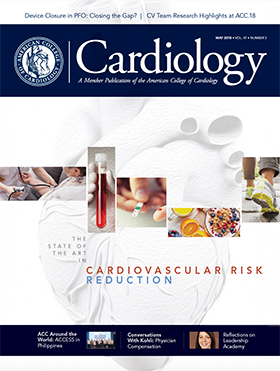JACC in a Flash
Featured topics and Editors' Picks from all of ACC's JACC Journals.
Is Caffeine Safe, Protective For Patients With AFib, Arrhythmias?

Some caffeinated beverages such as coffee and tea may be safe and may reduce the frequency of arrhythmias, according to a state-of-the-art-review published in JACC: Clinical Electrophysiology.
A single cup of coffee contains about 95 mg of caffeine and acts as a stimulant to the central nervous system. Once in the body, caffeine blocks the effects of adenosine, a chemical that can facilitate atrial fibrillation (AFib).
Aleksandr Voskoboinik, MBBS, et al., analyzed multiple population-based studies to determine an association between caffeine intake and its effects on atrial and ventricular arrhythmias (VAs). These studies have consistently shown a decrease in AFib with an increase in caffeine ingestion. One meta-analysis of 228,465 participants showed AFib frequency decreased by 6 percent in regular coffee drinkers. Further analysis of 115,993 patients showed a 13 percent risk reduction. Read More >>>
Caffeine had no effect on VAs. Caffeine doses up to 500 mg daily (equivalent to six cups of coffee) did not increase the severity or rate of VAs. A randomized study of 103 post-heart attack patients who received an average of 353 mg of caffeine a day resulted in improved heart rate and no significant arrhythmias. Only two studies showed an increased risk for VAs, in which patients ingested at least 10 cups and nine cups per day, respectively.
According to the authors, energy drinks should be avoided by patients with pre-existing heart conditions. One energy drink can contain anywhere from 160-500 mg of concentrated caffeine. Three quarters of patients with pre-existing heart conditions who consumed two or more energy drinks per day reported palpitations within 24 hours.
Both large population studies and randomized control trials suggest caffeine intake of up to 300 mg a day may be safe for patients with arrhythmia. However, there may be individual differences in susceptibility to the effects of caffeine on the factors that trigger arrhythmias in some, and up to 25 percent of patients report coffee as an AFib trigger. Patients with a clear temporal association between coffee intake and documented AFib episodes should accordingly be counseled to abstain. Future research looking at the relationship between heart rhythm and the impact of caffeine abstinence may be useful to further clarify this topic.
“Caffeinated beverages such as coffee and tea may have long term anti-arrhythmic properties mediated by antioxidant effects and antagonism of adenosine,” says Peter Kistler, MBBS, PhD, an author of the study. “In numerous population-based studies, patients who regularly consume coffee and tea at moderate levels have a lower lifetime risk of developing heart rhythm problems and possibly improved survival.”
Voskoboinik A, Kalman JM, Kistler PM. JACC Clin Electrophysiol 2018;4;425-32.
Do Heart Transplantation Centers Provide Equal Treatment?
Heart transplantation centers that “potentially overtreat” candidates may compromise the fair and efficient allocation of scarce donor hearts, according to a study presented at the International Society for Heart and Lung Transplantation’s Annual Meeting and Scientific Sessions in Nice, France, and simultaneously published in the Journal of the American College of Cardiology. Read More >>>
Using data from the Scientific Registry of Transplant Recipients, William F. Parker, MD, et al., examined the registrations of all U.S. adult heart transplantation candidates from 2010 – 2015 based on national variation in treatment intensity. “Potential overtreatment” was defined as treatment of a candidate who did not meet cardiogenic shock criteria with either high-dose inotropes or an intra-aortic balloon pump. A total of 12,762 adult candidates were listed as not in cardiogenic shock for heart transplantation.
Results showed that of these candidates, 1,471 (11.6 percent) were potentially overtreated with high-dose inotropes or intra-aortic balloon pumps. In the bottom quartile of transplantation centers, only 2.1 percent of candidates were potentially overtreated compared with 27.6 percent at top quartile centers, an interquartile difference of 25.5 percent (95 percent confidence interval [CI], 21-30 percent). Adjusting for candidate differences did not significantly alter the interquartile difference.
Furthermore, local competition with two or more centers increased the odds of potential overtreatment by 50 percent (adjusted odds ratio, 1.50; 95 percent CI, 1.07-2.11). The author’s note that this competition for transplantable hearts may be the reason for overtreatment of hemodynamically stable heart transplant candidates. The authors explain that widespread overtreatment can cause excess cost and unnecessary risk of therapy-related complications, as well as unfairly elevate the status of less urgent candidates. They conclude that therapy-based allocation systems will always be susceptible to manipulation and recommend developing an objective scoring system for heart allocation.
In an accompanying editorial comment, Larry A. Allen, MD, MHS, FACC, and Prateeti Khazanie, MD, MPH, note that while new allocation plans have the best intentions of solving disparities, fair play is not always natural. “Clinicians making heart transplant allocation decisions are rarely consciously and flagrantly overtreating patients to outwit, outplay and outlast one another,” they write. “We must continue to strive for an explicit and transparent system that ensures optimal fairness, within which clinicians can advocate for individual patients.”
Parker WF, Anderson AS, Hedeker D, et al. J Am Coll Cardiol 2018;Apr 14:[Epub ahead of print].
Review Discusses Hypertension Risk Across a Woman’s Life Cycle

Despite knowledge gaps that still exist, effective treatment and control of hypertension may improve cardiovascular outcomes affecting women in different phases of their life cycle, according to a state-of-the-art review published in the Journal of the American College of Cardiology.
Nanette K. Wenger, MD, MACC, et al., describe the burden that hypertension has on women, as it is among the “most important risk factors” for developing cardiovascular disease and accounts for about one in five deaths in U.S. women. They highlight ways hypertension affects women in multiple phases of life, with specific characteristics relating to risk factors in teenage and young adult women; pregnancy; use of oral contraceptives and assisted reproductive technologies, lactation, menopause or hormone replacement; elderly women; and issues of race and ethnicity. Read More >>>
The authors point out common risk factors that offer opportunities to affect hypertension and cardiovascular disease burdens in women, including obesity, physical inactivity, increased salt intake, diabetes and alcohol use. Sex-specific risk factors that mediate hypertension development include estrogen receptors and sympathetic nervous system activation, pregnancy complications like pre-eclampsia and combinations of modifiable factors.
To control these risk factors, the authors encourage a multipronged approach to blood pressure management in women throughout all stages of life. “Critically important for U.S. women, hypertension carries the highest attributable risk for all-cause, as well as cardiovascular mortality and cognitive impairment; among modifiable risk factors, blood pressure management is a key health care priority for all women, particularly elderly women,” the authors write.
The authors note that knowledge gaps persist such as the contribution of hypertensive disorders of pregnancy to future cardiovascular disease in women, postpartum surveillance of women and optimal management of pre-eclampsia. They add that some believe that “optimal blood pressure targets have not been established by the highest level of evidence, particularly for older women.”
Despite the need for further specific research on hypertension in women, the authors conclude that “control of hypertension reduces cardiovascular disease-related adverse outcomes that contribute to poor quality of life, disability and health care resource consumption.”
Wenger NK, Arnold A, Bairey Merz CN, et al. J Am Coll Cardiol 2018;71:1797-1813.
Women Less Likely to Receive High-Intensity Statins After MI
Less than half of women who filled a statin prescription following myocardial infarction (MI) received a high-intensity statin – indicating they continue to be less likely than men to be prescribed this treatment, according to a study published in the Journal of the American College of Cardiology. The persistent gap in heart disease treatment between women and men continues despite similar effectiveness of more-intensive statins for both sexes and recent efforts to reduce sex differences in guideline-recommended treatment.
Using the MarketScan and Medicare databases, Sanne A.E. Peters, PhD, et al., analyzed data from 88,256 U.S. adults who filled a statin prescription within 30 days after hospital discharge for MI between January 2014 and June 2015. High-intensity doses were the first statin prescription fill following hospital discharge after MI for 47 percent of women and 56 percent of men. Trends in sex differences in high-intensity statin use over time were examined using beneficiaries with the same inclusion criteria between January 2007 and June 2015. Read More >>>
Overall, high-intensity statin prescription fills increased from 22 percent to 50 percent in women and from 27 percent to 60 percent in men. The difference in the use of high-intensity statins after MI between sexes was larger among the youngest and oldest patients and among those without comorbidities. Women were consistently less intensively treated across a broad range of patient characteristics.
Researchers found no evidence of the sex difference in the use of high-intensity statins post MI diminishing between 2007 and 2015 or following the publication of the 2013 American College of Cardiology/American Heart Association Guideline on the Treatment of Blood Cholesterol to Reduce Atherosclerotic Cardiovascular Risk in Adults, which recommends the use of high-intensity statin therapy for women and men less than 75 years of age with established heart disease for secondary prevention. The researchers said clinicians may perceive women who have experienced MI to be at a lower risk of recurrence than their male counterparts.
“Clinicians should communicate the benefits of high-intensity statins to their female patients in terms of reducing the risk of another heart attack and discuss possible concerns about side effects,” Peters says. “Moreover, clinicians themselves should also be aware of the risk of recurrent heart attack in their female patients and the persistent sex disparity in the utilization of high-intensity statins.”
Peters SAE, Colantonio LD, Zhao H, et al. J Am Coll Cardiol 2018;71:1729-37.
Keywords: ACC Publications, Cardiology Magazine, Adenosine, Adolescent, Ambroxol, American Heart Association, Anti-Arrhythmia Agents, Antioxidants, Atrial Fibrillation, Blood Pressure, Breast Feeding, Caffeine, Cardiovascular Diseases, Central Nervous System Stimulants, Cholesterol, Comorbidity, Confidence Intervals, Contraceptives, Oral, Diabetes Mellitus, Electrophysiology, Heart Atria, Heart Diseases, Heart Rate, Heart Transplantation, Hydroxymethylglutaryl-CoA Reductase Inhibitors, Hypertension, Lactation, Lung Transplantation, Nonprescription Drugs, Medicare, Menopause, Myocardial Infarction, Nervous System, Obesity, Odds Ratio, Postpartum Period, Pre-Eclampsia, Pregnancy, Quality of Life, Receptors, Estrogen, Registries, Reproductive Techniques, Assisted, Risk Reduction Behavior, Risk Factors, Secondary Prevention, Sex Characteristics, Shock, Cardiogenic, Sympathetic Nervous System, Transplantation
< Back to Listings

